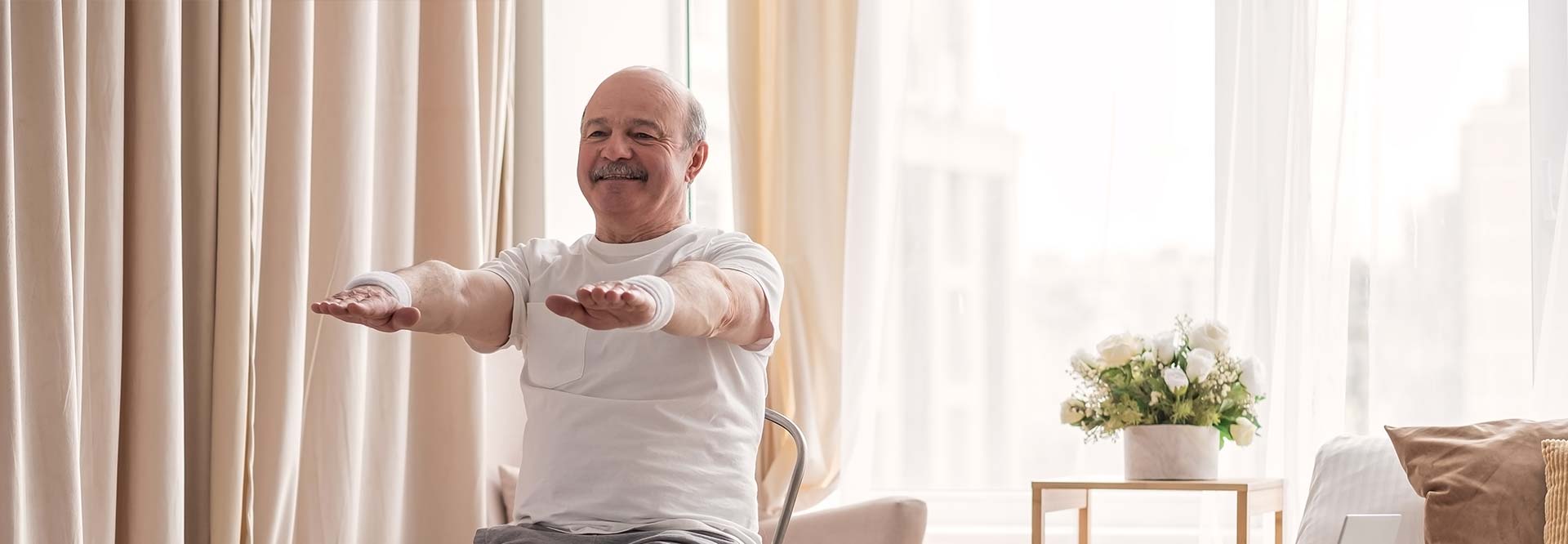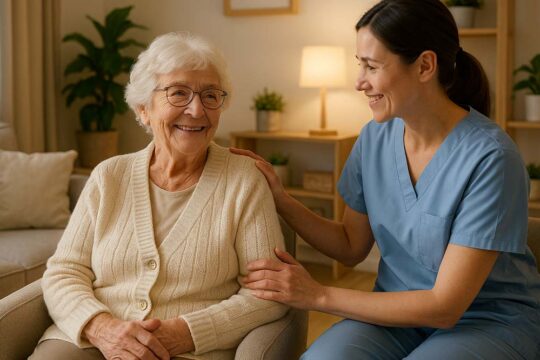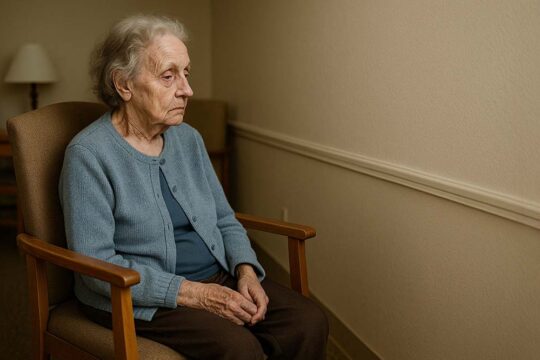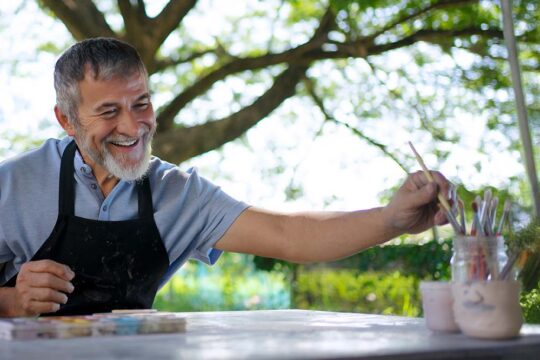
Improving Mobility in the Elderly
Improving mobility in the elderly is important so they can maintain independence and quality of life. Daily exercises focusing on strength, flexibility, balance, and endurance help achieve this goal. At Stellar Care, our deep appreciation for the importance of our residents’s physical activity, health, and mobility, shines through in our commitment to enriching their happiness and quality of life.
How to Improve Mobility in Elderly Parents & Loved Ones
Low Impact Cardio
Incorporating low-impact cardio exercises into a senior’s routine can significantly improve mobility issues. These exercises increase heart rate and improve cardiovascular health without placing excessive stress on the joints, making them ideal for older adults who may be dealing with arthritis, osteoporosis, or general frailty. Benefits include:
- – Enhanced circulation and reduced risk of heart disease
- – Increased strength, stamina, and endurance.
- – Improved balance and coordination which reduces the risk of falls.
- – Overall stability.
- – Enhanced Flexibility and Range of Motion for joint health
- – Weight Management
- – Potential mental health benefits
Warm up and cool down
Exercise warm-ups and cool-downs can improve mobility in seniors and reduce the risk of injury.
Warm-Up Benefits:
- – Increases Body Temperature: Gradually increases muscle temperature, making muscles more elastic and less prone to injuries.
- – Improves Blood Circulation: Enhances blood flow to muscles, preventing sudden strains during exercise.
- – Boosts Joint Mobility: Gentle, dynamic stretching during warm-ups increases the range of motion in joints, aiding in better mobility.
- – Prepares the Cardiovascular System: Gradually increases heart rate, reducing the stress on the heart when transitioning to more intense activities.
Seniors should consult with a healthcare provider before starting any new exercise regimen, especially for those with existing health conditions.
Cool-Down Benefits:
- – Aids in Recovery: Gentle activities during cool-down help the body dispose of metabolic waste products more efficiently, reducing stiffness and soreness.
- – Reduces Heart and Breathing Rates Gradually: Prevents blood pooling and dizziness by ensuring a smooth transition from exercise back to the state of rest.
- – Improves Flexibility: Incorporating stretching in the cool-down phase can increase flexibility, contributing to better mobility.
- – Promotes Relaxation: Helps the body transition into a state of rest, reducing the immediate post-exercise risk of injury and promoting mental well-being.
Go for a walk every day
When an elderly person can’t walk, they are at an increased risk of falling. Consistent daily walking provides seniors with benefits that directly contribute to improved mobility, including:
- – Increased Muscle Strength: Walking strengthens the muscles in the legs and core, providing better support and stability.
- – Enhanced Joint Health: Movement lubricates the joints, which reduces pain and stiffness from arthritis.
- – Improved Balance: Walking challenges the body’s balance systems, improving overall stability and reducing the risk of falls.
- – Boosted Cardiovascular Health: Walking is a cardiovascular exercise that improves heart health, circulation, and endurance, making daily activities easier to perform.
- – Greater Flexibility: Regular walking maintains the range of motion in your joints, for better mobility.
- – Weight Management: Walking helps control weight, reducing strain on joints and improving mobility.
- – Mental Health Benefits: The mental health benefits of walking, like reduced stress and improved mood, can motivate seniors to stay active and mobile.
For seniors with mobility issues, start slowly and gradually increase the duration and intensity of walks. Using appropriate walking aids, choosing safe, flat routes, and wearing comfortable footwear make walking a beneficial, enjoyable activity.
Stretch regularly
Daily stretching exercises to improve mobility in elderly people can improve flexibility and reduce stiffness. Some of the benefits of stretching include:
- – Increases Flexibility: Maintains or improves joint range of motion, aiding in daily activities.
- – Reduces Stiffness and Pain: Alleviates muscle stiffness and reduces arthritis-related discomfort.
- – Improves Posture: Corrects and maintains posture by relieving muscle tension.
- – Enhances Circulation: Boosts blood flow to muscles, aiding in recovery and nutrient delivery.
- – Prevents Injuries: Flexible muscles are less prone to strains and sprains, reducing injury risk.
- – Promotes Balance: Improves balance and coordination, crucial for fall prevention.
- – Supports Independence: Facilitates daily living activities, promoting independent living.
Practice correct posture
Maintaining correct posture is important for seniors to improve and maintain mobility as they age. Becoming aware of one’s posture is the first step to improvement. Regularly check and adjust posture to ensure the back is straight, shoulders are back, and the head is aligned with the spine. Strengthen core muscles. A strong core supports the spine and can significantly improve posture. Activities that strengthen back muscles help maintain an upright posture.
Regularly practicing squeezing the shoulder blades together can help counteract the tendency to slouch, reinforcing good posture. Stretching the neck and shoulders helps relieve tension and encourages proper alignment. Gentle neck rolls and shoulder stretches are effective. Use chairs with proper back support, keep frequently used items within easy reach, and ensure computer workstations are ergonomic. Walking while maintaining a straight line from the head through the shoulders and spine down to the feet reinforces good posture habits. A physical therapist can provide exercises and tips for improving posture.
By integrating these practices into their daily routine, seniors can improve their posture, which improves mobility and reduces the risk of falls and injuries.
Balance and coordination
As they experience increased health issues due to aging, seniors’ sense of balance and coordination begins to deteriorate at around age 50. By age 65, seniors who have already experienced balance issues are more at risk for falls. Before treating balance issues, the cause must be determined by a medical professional. These could include various diseases and conditions like vision problems, heart disease, strokes, neurological disorders, inner ear problems, diabetes, dehydration, alcohol abuse, or issues with prescription medications.
Physicians may recommend physical therapy to improve balance and coordination for seniors who are struggling with these issues.
Seniors who don’t have medical conditions affecting their balance or coordination can improve them through activities such as heel-to-toe walking, one-leg stands, and practicing Tai Chi, dance, or chair yoga.
Assistance devices may help some seniors when they are experiencing an increase in balance and coordination problems. Canes or walkers can aid the elderly in many situations so they don’t fall. Handles near toilets and showers, along with motorized chairs are devices to improve safety for seniors, particularly as their balance declines. These aids contribute significantly to their independence.
Proper nutrition
By providing essential nutrients needed for muscle strength, joint health, and overall energy levels, proper nutrition improves mobility among seniors. Protein intake supports muscle repair and growth and maintains muscle mass and function. Calcium and vitamin D are vital for bone health, reducing the risk of fractures and osteoporosis, while omega-3 fatty acids found in fish alleviates joint inflammation, enhances flexibility, and reduces pain. Antioxidant-rich foods combat oxidative stress, protecting against cellular damage. A balanced diet can enhance seniors’ mobility, and reduce the risk of falls and injuries, so they maintain their independence. Our Stellar Care staff offers freshly prepared meals three times a day to ensure our residents receive proper nutrition.
Daily exercises at Stellar Care to improve mobility in elderly
At Stellar Care, we deeply understand the transformative power of physical activity on the health and happiness of our senior residents. Many of our Stellar Care residents enjoy daily exercise classes like gentle stretching, chair exercises, balloon battle, chair dancing, morning workout, bean bag toss, and afternoon stretch. These physical activities improve the quality of their lives and their overall health and mobility by improving impaired coordination and balance. Every activity is crafted with care and respect for our residents’ capabilities and comfort. Our creative, engaging sessions which are offered Monday through Sunday add a joyful spirit to the day while improving mobility.
Beyond the immediate benefits of increased mobility and reduced risk of falls, these exercises play a vital role in improving bone density and cardiovascular health, essential components of a long and vibrant life. Each class is more than just a physical activity session; it’s an opportunity for our residents to come together, support one another, and enjoy the immense benefits of staying active in a nurturing and understanding environment. At Stellar Care, we are committed to enhancing the quality of life of our elderly residents through thoughtful, carefully designed exercise classes that reflect our deep compassion and dedication to their well-being.
Related Articles
- – Why Do Elderly Lose Balance?
- – Hallucinations in the Elderly
- – Alzheimer’s Home Safety Checklist
- – Responsibility for Elderly Parent Driving
- – How to Know Elderly Parents Need Help
Discover the key differences between retirement homes and assisted living to help you choose the right care for your loved one’s needs.
Learn the risks of leaving a dementia patient alone, legal responsibilities, care strategies, and how to plan for their safety.
Learn why dementia patients wander at night, how to prevent it, and when memory care is the safest option for your loved one in San Diego.
Compare memory care and assisted living, from services and costs to safety and staffing, to find the right senior care in San Diego.



